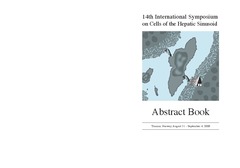Liver sinusoidal endothelial cells represents an important blood clearance system in pigs
Permanent lenke
https://hdl.handle.net/10037/1143DOI
doi:10.1186/1476-5926-2-1Dato
2003-01-03Type
Journal articleTidsskriftartikkel
Peer reviewed
Forfatter
Nedredal, Geir I.; Elvevold, Kjetil H.; Ytrebø, Lars M.; Olsen, Randi; Revhaug, Arthur; Smedsrød, BårdSammendrag
Background:
Numerous studies in rats and a few other mammalian species, including man, have shown that the sinusoidal cells constitute an important part of liver function. In the pig, however, which is frequently used in studies on liver transplantation and liver failure models, our knowledge about the function of hepatic sinusoidal cells is scarce. We have explored the scavenger function of pig liver sinusoidal endothelial cells (LSEC), a cell type that in other mammals performs vital elimination of an array of waste macromolecules from the circulation.
Results:
125I-macromolecules known to be cleared in the rat via the scavenger and mannose receptors were rapidly removed from the pig circulation, 50% of the injected dose being removed within the first 2–5 min following injection. Fluorescently labeled microbeads (2 μm in diameter) used to probe phagocytosis accumulated in Kupffer cells only, whereas fluorescently labeled soluble macromolecular ligands for the mannose and scavenger receptors were sequestered only by LSEC. Desmin-positive stellate cells accumulated no probes. Isolation of liver cells using collagenase perfusion through the portal vein, followed by various centrifugation protocols to separate the different liver cell populations yielded 280 × 107 (range 50–890 × 107) sinusoidal cells per liver (weight of liver 237.1 g (sd 43.6)). Use of specific anti-Kupffer cell- and anti-desmin antibodies, combined with endocytosis of fluorescently labeled macromolecular soluble ligands indicated that the LSEC fraction contained 62 × 107 (sd 12 × 107) purified LSEC. Cultured LSEC avidly endocytosed ligands for the mannose and scavenger receptors.
Conclusions:
We show here for the first time that pig LSEC, similar to what has been found earlier in rat LSEC, represent an effective scavenger system for removal of macromolecular waste products from the circulation.
Forlag
BioMed CentralSitering
Comparative Hepatology 2(2003), article no 1 pp 14Metadata
Vis full innførselSamlinger
Følgende lisensfil er knyttet til denne innførselen:
Relaterte innførsler
Viser innførsler relatert til tittel, forfatter og emneord.
-
Influence of environmental tonicity changes on lipophilic drug release from liposomes
Nikolaisen, Trygg Einar (Mastergradsoppgave; Master thesis, 2018-05-15)Introduction: Liposomes as drug delivery systems has been widely studied as a way to solubilize poorly soluble drugs, reduce side effects of chemotherapeutics and increase circulation time in vivo. Since the first descriptions of liposomes over 60 years ago, they have shown tendencies to shrink and swell when the external environment of the liposomes is altered. This phenomenon has been studied in ... -
Prognostic Impacts of Angiopoietins in NSCLC Tumor Cells and Stroma : VEGF-A Impact Is Strongly Associated with Ang-2
Andersen, Sigve; Dønnem, Tom; Al-Shibli, Khalid Ibrahim; Al-Saad, Samer; Stenvold, Helge; Busund, Lill-Tove; Bremnes, Roy M. (Journal article; Tidsskriftartikkel; Peer reviewed, 2011)Angiopoietins and their receptor Tie-2 are, in concert with VEGF-A, key mediators in angiogenesis. This study evaluates the prognostic impact of all known human angiopoietins (Ang-1, Ang-2 and Ang-4) and their receptor Tie-2, as well as their relation to the prognostic expression of VEGF-A. 335 unselected stage I-IIIA NSCLC-patients were included and tissue samples of respective tumor cells and ... -
14th International Symposium on Cells of the Hepatic Sinusoid
Smedsrød, Bård (Book; Bok, 2008-08-31)Abstract book of the symposium


 English
English norsk
norsk


